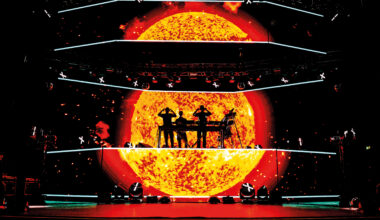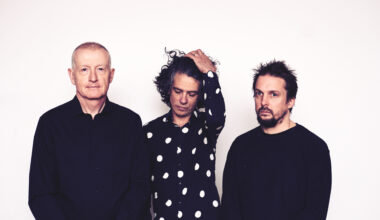Eight years after the mind-melting experience that was ‘ISAM’, Amon Tobin returns with ‘Fear In A Handful Of Dust’, another masterful and opaque work of exquisite sound design and strange beauty. Is this neo-musique concrète?
How to understand the music of Amon Tobin? To listen to his new album, the beguiling, confounding spiral of sounds, musical and otherwise, which he’s called ‘Fear In A Handful Of Dust’, is to enter a haunted fairy tale world where you can easily lose your way, where traditional meaning falls away, as if the very ground beneath your feet is shifting. There are echoes of San Francisco Tape Music Center here and there, particularly Morton Subotnick’s ‘Silver Apples Of The Moon’, but the whole of Amon’s output under his own name since 2011 feels like a polished, sci-fi rendering of the ideas and techniques of musique concrète: record sound, loop sound, cut up sound, mess with sound, rearrange sound, create new sound… repeat.
Audio tape, the carrier and enabler of musique concrète, was where Amon Tobin was at as a kid. The fluidity and manipulable quality of the medium made itself clear to him early on when he would record the Top 40 off the radio on his twin-deck Toshiba cassette machine, purchased with cash earned washing cars in Hastings, the British seaside town. He would then edit the recordings, first removing tracks he didn’t like, before progressing to editing out the parts of the songs he wasn’t keen on, all with the deft use of the pause and record buttons. When he first got his hands on a sampler, he thought of it as “a huge tape machine”.
In 2019, no one evolves sound quite like Amon Tobin. You can almost imagine him examining and polishing each sound he uses, like a jeweller inspecting his gems through an eyepiece, before placing them back into the mix in just the right place to create a sonic experience of captivating abstracted beauty. He describes his work as a “never-ending personal art project”, which certainly makes him sound more like a student of Pierre Henry than a contemporary DJ-turned-producer.
“Musique concrète is the art of decision,” Pierre Henry once said. “It’s the art of choice. You select one sound over others and that’s where composing begins.” It could be Amon Tobin talking.
“That’s a very lofty association!” says Amon when I put it to him that while he’s perceived as a lord of electronic dance music, what he’s actually doing is neo-musique concrète.
“For me,” he says, enthused about discussing the topic, “there was a massive turning point in music with the idea of recorded sound, and loopable sound actually; taking any arbitrary aspect of the world sonically and finding rhythm or melody in it by virtue of the fact that’s it’s repeated. Its kind of fascinating, and I’m sure it was to the musique concrète composers, too. It’s fascinating to be able to repeat real life, to reliably repeat it. It’s like taking a picture of something, a freeze-frame of a moving image, but capturing all energy of movement in that freeze-frame, so it’s like a little capsule of moving energy… there’s got to be a better word…”
He falters, grasping for it.
“Motion…” he says, but he’s still not got it quite right, you can tell by his furrowed brow and the tone of his voice. “To extract from its context, to still maintain its intention. There’s something really valuable in that, and I definitely use that fully throughout what I’ve done, for sure. I feel a lot of affinity with musique concrète. And with the spirit of it, of exploration, of discovery, which was central what they were doing. And the genuine excitement that you’re doing something which isn’t functional, it’s exploratory, it’s full of hits and misses, but it ultimately pushes things forward.”
Amon comes from a tradition which tends to narrowly define electronic music as music made for dancing. He’s well aware of it, and has placed a lot of energy into exploding that expectation.
“It’s too bad that when you say you make electronic music to most people,” he says, “they assume that it means dance music. I mean, I love dance music, but I feel that electronic music inhabits a far wider definition. And people like Pierre Schaeffer obviously weren’t making music for dancing, they were trying to find out how sound worked and what you could do with it, and that’s very much my focus too.”
As if to further manifest this paradox of electronic music being both high art and escapist dance music, Amon, under his Two Fingers alias, played at Bangface last month, the Pontins-based rave-up fancy dress gathering of 5,000 day-glo banner waving loons who also were dancing to the music of (checks notes) Shitney Beers and Spongebob Squarewave. Mind you, Pierre Henry very much made music for dancing. It was ballet, of course, but I’m sure his ‘Psyché Rock’ piece from ‘Les Jerks Électroniques De La Messe Pour Le Temps Présent’ for French choreographer Maurice Béjart would have gone down a treat at Bangface. Music and movement: forever intimately bound together.
We’ll try to unpick the new album’s meaning in a bit. But first perhaps we should tackle a more, erm, concrete change in Amon’s modus operandi. He’s only gone and launched his own record label, hasn’t he? It’s called Nomark, which is either a self-deprecating gag, or a stab at a Naomi Klein ‘No Logo’ anti-brand aesthetic. Or both. But why, after more than 20 years with the eminently cool label Ninja, has he become a record label guy?
“Well, I found I was becoming increasingly dissatisfied with trying to cover too much ground in any one piece of music I make,” he explains, also slightly haltingly – he hasn’t, he confesses, really had time to think through how to present Nomark coherently. “For instance, a lot of the records I made in the mid-90s tried to stride across a few areas of interest for me, and I kind of bundled a lot of sound explorations together. It was good, but as I got a little deeper and less superficially interested in all these aspects of sounds, I found they had to occupy more space, they can’t really try to do too many things at once. I like the idea of focus in music, trying to do just one thing, and so the antidote was to make aliases to split things up.”
This he did in 2006, when he created his above mentioned Two Fingers alias. Two Fingers enabled him to hive off his dancefloor science and freed up Amon Tobin go on a journey into the heart of sound. The trouble was that his output now came too thick and fast for the release schedules of a record label, even one as flexible as Ninja. It was also an act of self-determination, taking ownership of his musical assets.
“There are really tedious things to talk about,” he nods, “like publishing and mastering rights, and all those kinds of things I bore myself thinking about, but those are considerations, too. You can’t say all artists should be completely independent and fuck the labels – and I’ve got nothing but good things to say about Ninja – it depends where you are and what your relationship is with your fan base, your level of establishment, all of those things.”
‘Fear In A Handful Of Dust’, as all poetry enthusiasts will recognise immediately, is a line from TS Eliot’s landmark modernist poem ‘The Waste Land’. Published in 1922, it marked a shift from traditional 19th century poetry of rural imagery, wandering lonely as a cloud and all that, to experimental work that embraced life as part of the reality of the 20th century’s post-industrial age of cities and factories. The album alternates between melodic and almost romantic interludes like ‘On A Hilltop Sat The Moon’ and ‘Pale Forms Run By’, and arrangements of sliced electronic noise and sound like ‘Freeformed’ and ‘Heart Of The Sun’, the latter sounding like sneaked spy recordings of mysterious long-wave radio transmissions, all fading static and peculiar unearthly modulations.
If, like me, you start looking for parallels with Eliot’s great work, and the groundshift it ushered in, you might find them. You can, if you like, detect the submerged structure of ‘The Waste Land’ in this album, a sound art response to its themes and rhythms and the impact the poem made. But you’d be wrong.
“You know,” Amon sighs, when I bring this up, “when it comes to titles for tracks and albums, if I could just number all my tracks, I probably would, to be entirely honest. I don’t ever think about that stuff at all. ’Supermodified’ [the title of his 2000 album] was written on a shoebox in my studio. Cujo [his first alias, back in 1995] I’d just seen on TV, and this album’s title was a phrase my friend had seen in some pulp fiction, and then we figured out it was from ‘The Waste Land’, which I do remember reading, but it certainly wasn’t the inspiration or the cornerstone for the album. It does seem to embody the spirit, poetically, the aesthetic of the record, it seemed to work, but it’s a very superficial thing.”
So it’s not a reference to modernism?
“No!”
I feel like the fried hippy who turns up in John Lennon’s garden in the film ‘Imagine’. He was camping in the bushes, a head full of theories and certainties about hidden meanings in Beatles songs, only to be told by Lennon face-to-face that he was wrong.
OK. Sad face icon. But there’s more to delve into here. The album’s artwork features a painting: a dark forest, a fecund deep green. Two large trees frame the scene, and each has an opening from which flood beams of red and green light. And in each pool of light stands a weird feathered creature with horns. This same horned man-bird thing appears in other images, standing on the platform of the Brooklyn Bridge subway station in New York. He must be the ‘Velvet Owl’, which is the title of the album’s seven-minute centrepiece track. This must have a meaning, surely…
“No, not really,’ chuckles Amon. “With a lot of the music on this record I’m just exploring what my idea of beauty and warmth might be. And all those squishy words, which I don’t have a great handle on, which is why I make the music. I’ve been trying to make the most beautiful sounds and most beautiful melodies and ‘Velvet Owl’, it’s just a silly title.”
Really? He might be obfuscating here. Is he cloaking his art with a barrier of reserve and nonchalance?
“I actually got it from a Stewart Lee stand-up thing,” he says when I press him. “I think he said Gary Lineker has a face like a velvet owl, which really made me laugh. I don’t know if there was something about the softness of that image that fitted well with the round tones in that track… I wish I could say something more clever about my titles, but I’m afraid they really are an afterthought.”
Get the print magazine bundled with limited edition, exclusive vinyl releases
If all this is starting to sound like Amon Tobin is the kind of composer who isolates himself in a hermetically sealed laboratory of sound for extended periods, to emerge triumphantly clutching a sonic test tube of completed experiments, only to then realise he has to now find a way of communicating this amazing discovery to the rest of the world, well…
“Look,” he says, amused, “I’m afraid all I care about is the music. That’s really it.”
So all the rest of it: the track titles, what he’s going to call the album, how to release the work, how he’s going present it in a live context, all of these things are problems that require solutions, they’re problems caused by the creation of the music. Nomark, the Velvet Owl character, the name lifted from one of the greatest poem of the 20th century, these are all solutions. This is all very… algorithmic.
“It’s not like it’s a plan,” he responds. “It’s more like I’m making all this music, and I’m figuring out how I can possibly release it in a coherent way, in a way that makes sense. How I share what I do is always my last consideration. It’s always very personal, to do with fulfilling a sort of desire I have in me to explore an idea. At the very end of that process I’m faced with, ‘Oh shit, now I have to think about how other people are going hear it’. And that’s always a puzzle to me, and I have to piece it together, to construct it.
“It’s a bit like the ‘ISAM’ show, it was like, ‘Oh no, I’ve got an album that doesn’t have any musicians, and there’s no way to perform it live, it’s not dance material so I can’t DJ it’, so you end up creating a show that can somehow house that and make it work. And it’s the same with this. I just make all this stuff, and I’m like, ‘Shit, now what can I do with all this?’.”
‘ISAM’ was part-sound design, part-melodic tour de force, part-cut up collage. It holds together as a coherent work, as all of Tobin’s impressive catalogue does, in ways that are hard to quantify. But it’s in the attention to detail, the ability to hear qualities in the sound, the squirts and boinks made by water, by engines, by bells, by anything that catches his ear, and then to adapt and weave those sounds into a broader piece. It all ended up creating a live tour that defied categorisation and placed sound in an epic context of volume and visuals with Amon perched inside a huge video-mapped collection of cubes.
Pieces like ‘Goto 10’ start like a hyper-clean musique concrète, before taking underpant-wrenching dubstep sounds and messing with them in a way that suggests a song, but then fails to become one, instead it’s a detailed description of power and movement and its impact on its surroundings. Pre-echoes of ‘Fear In A Handful Of Dust’ can be heard in ‘ISAM’, like the delicacy vs monster dynamics of ‘Lost & Found’, or the hallucinatory nursery rhyme mess of ‘Wooden Toy’, but ‘ISAM’ had a relentless brutality about it, sweetened by its sweeping vision, whereas ‘Fear In A Handful Of Dust’ is operating on a more intimate human scale.
We don’t yet know if Amon Tobin has plans to take this album into the live arena. Pierre Henry, the co-founder of musique concrète, parted ways with Pierre Schaeffer in the early 1950s and set up his own studio, APSOME (Applications de Procédés Sonores en Musique Électroacoustique), in his home in the 12th arrondissement of Paris. He lived, recorded and performed concerts there. The house became a crumbling embodiment of Henry’s music, of the man himself. ‘ISAM’ (Invented Sounds Applied to Music, remember – check out the academic cred of that title…), the live show, felt a little like that. There was Tobin, sealed inside a cube, part of an asymmetric cliff face of cubes, a torrent of extraordinary sound emerging from his fingertips, while the structure he was a part of pulsed and flashed and glowed in synchronous harmony.
It’s all a long way from the schoolboy in Hastings with his double cassette machine, instinctively editing tape to shape music to his own ends. And even further from the tape music being produced in Paris 70 years ago by Pierre Schaeffer and Pierre Henry. But, like a tape loop, it all comes back round eventually, and as it repeats, the shapes reveal themselves to you, the chaos settles into comforting patterns, and a new way of listening opens up.
‘Fear In A Handful Of Dust’ is out on Nomark.


